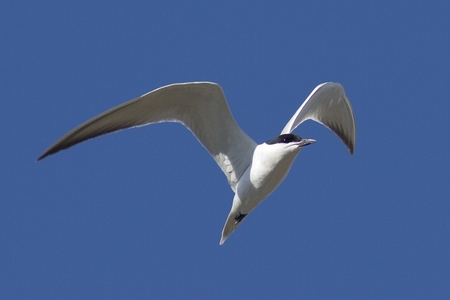Gelochelidon nilotica nilotica
Family: Laridae
Length: 33 – 42 cm
Wingspan: 76 – 103 cm
Weight: 150 – 300 g

Identification
Appearance: medium-sized tern with white body, very pale grey wings with black in tips, a black cap (when breeding), a strong black bill and black legs.
Distinguishing characteristics: robust body, short thick gull-like bill, broad wings, long legs, no crest.
Flight: agile (prey are caught in flight and on the surface of the water), graceful but rather steep (wings held straight, less bent backwards).
Sound: caracteristic call « ker-wik »
Ecology and habitat
Nest: shallow depressions scraped in sand or mud, lined with some vegetation, near coastal lagoons or inland near salt marshes.
Diet: feeds on insects, small mammals, amphibians, crustaceans and sometimes eggs, chicks and fish. Unlike other terns, the gull-billed tern mainly seeks its food on the land.
Behaviour at sea: rarely found over the ocean.
* This map indicates coastal nesting sites in the Mediterranean and adjacent Seas.
Distribution and movement
Breeding: the species is cosmopolite; the subspecies Gelochelidon nilotica nilotica is found in Europe, North Africa through the Middle East & south-central Asia to western China & Thailand.
Western population: mediterranean countries of western Europe and some African localities (North Africa, Mauritania, Senegal). Eastern population: Balkan Peninsula, Greece, shores of the Black Sea
and Sea of Azov, Turkey).
Wintering: in sub‐Saharan Africa for the western population (migration routes through Italy–Sicily and through the Strait of Gibraltar); in countries bordering the Rift Valley i.e. Uganda, Tanzania and Kenya (migration through the Nile basin).
Phenology: Incubation: 22-23 days; two or three eggs. Fledging: 28-35 days after hatching.
Conservation
Global population estimate: Mediterranean population: 5,800-7,150 pairs.
Threats: deterioration and loss of habitat, human disturbance at breeding colonies.
Protection level: Barcelona Convention : Annex II; Bern Convention : Annex II; Birds Directive : Annex I; IUCN Red List: Critically Endangered.
Some key references
Sánchez J. M., del Viejo A. M., Corbacho C., Costillo E., Fuentes C. 2004. Status and trends of Gull-billed Tern Gelochelidon nilotica in Europe and Africa. Bird Conservation International 14(4): 335-351.
